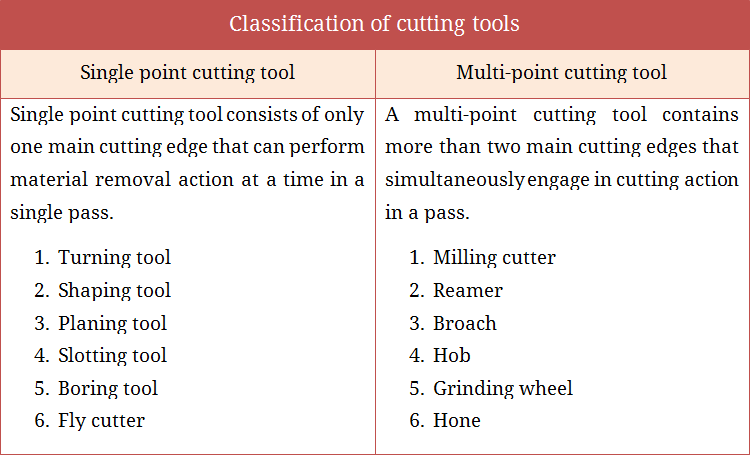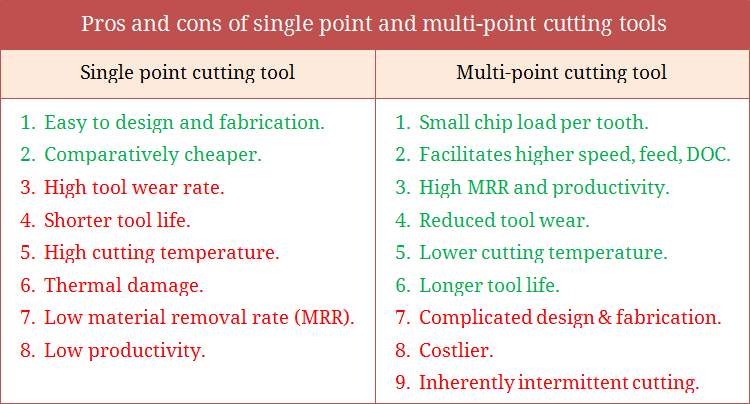Design Of Multipoint Cutting Tool
Cutting Tool is a wedge shaped device that actually removes (shears off) excess material from a preformed blank in order to obtain desired shape, size and accuracy. While machining or metal cutting operation, the cutter forcefully compresses a thin layer of material in the workpiece and gradually shears it off. However, to remove material, three relative motions are necessary. These motions actually provide necessary cutting velocity, feed velocity and depth of cut. Cutting tool itself cannot provide any such motion as it is rigidly mounted on tool holder in machine tool. All necessary motions are supplied by machine tool using various arrangements.
Classification of cutting tools
Although basic shape of cutting tool varies greatly with the type of operation it is intended to perform, every cutting tool must contains a wedge shaped portion with a sharp cutting edge, which can cut material smoothly. Now, a cutting tool may contain one or more main cutting edges that participate in cutting action at a time in a single pass. Cutting tools can be classified in various ways; however, the most common way is based on the number of main cutting edges that participates in cutting action at a time. On this basis, cutting tools can be classified into three groups, as given below.
- Single point cutting tool
- Double point cutting tool
- Multi point cutting tool

What is multi point cutting tool?
A multi-point cutting tool contains more than two main cutting edges that simultaneously engage in cutting action in a pass. Sometime, cutters with two cutting edges (more than one) are also considered multi-point cutting tools (instead of considering it as a double point cutter). The number of cutting edges present in a multi-point cutter may vary from three to few hundreds. Since cutting edge appears at the intersection of rake surface and flank surface, so a set of rake surface and flank surface also exists for each cutting edge.
Examples of multi-point cutting tool
Milling cutters are the common example for this category. Except fly milling cutter (a single point cutter), others are usually multi-point cutter. It can contain three cutting edges (say small end mills) to as high as 40 cutting edges for heavy duty large cutters. Apart from milling cutters, few other examples of multi-point cutter are enlisted below.
- Reamer (tool for reaming operation)
- Broach (tool for broaching operation)
- Hob (tool for hobbing operation)
- Grinding wheel (abrasive cutter)
- Hone (tool for honing operation)
Advantages of multi-point cutting tool
- Since total feed rate or depth of cut is equally distributed among all cutting edges, so chip load on each cutting edge reduces greatly. Thus higher feed rate or depth of cut can be utilized to improve material removal rate for enhancing productivity.
- Because of the distribution of chip load, force acting on each cutting edge reduces significantly. Sometime, one component of cutting force as a whole gets eliminated/reduced automatically (resultant of one cutting force component in a particular direction may become zero).
- During machining, none of the cutting edge remains in continuous contact with the work piece; instead, engagement and disengagement occur repeatedly. This provides sufficient time to disperse heat from the tool body, which protects the cutter from excessive heating and plastic deformation. Thus lower rate of increase in tool temperature is observed due to intermittent cutting action.
- Due to lesser period of engagement and lesser heat accumulation within the tool body, tool wear rate also reduces. Consequently, life of the cutter increases.
Disadvantages of multi-point cutting tool
- Due to intermittent cutting, cutting edges or teeth are subjected to fluctuating load. This creates noise, vibration and endurance failure of the cutter.
- Design and fabrication of the cutter is comparatively difficult. This makes such cutter costlier.

References
- Book: Machining and Machine Tools by A. B. Chattopadhyay.
- Book: Metal Cutting: Theory And Practice by A. Bhattacharya.
- Book: Manufacturing Process for Engineering Materials by S. Kalpakjain and S. Schmid.
- Book: Geometry of Single-point Turning Tools and Drills – Fundamentals and Practical Applications by V. P. Astakhov.
Design Of Multipoint Cutting Tool
Source: http://www.minaprem.com/machining/cutter/introduction/multi-point-cutting-tool-examples-advantages-and-disadvantages/
Posted by: mashburnguideare.blogspot.com

0 Response to "Design Of Multipoint Cutting Tool"
Post a Comment